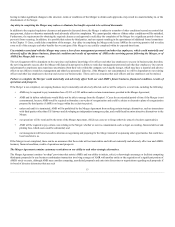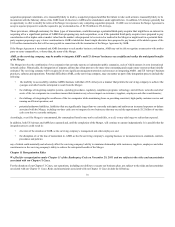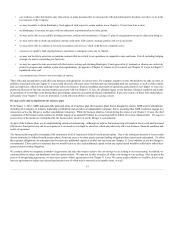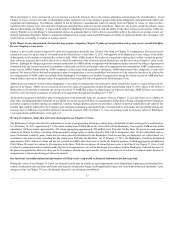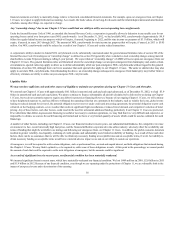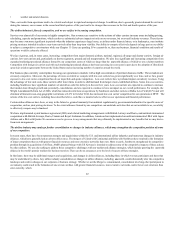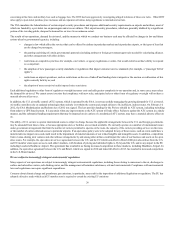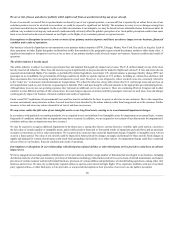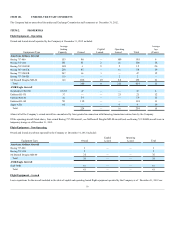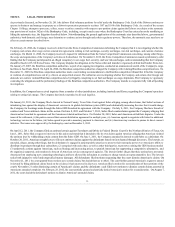American Airlines 2012 Annual Report Download - page 23
Download and view the complete annual report
Please find page 23 of the 2012 American Airlines annual report below. You can navigate through the pages in the report by either clicking on the pages listed below, or by using the keyword search tool below to find specific information within the annual report.
could have a material adverse effect on our competitive position and adversely affect our business, financial condition and results of operations. For similar
reasons, changes in airline alliances could have a similar adverse impact on us, whether or not the Merger is consummated.
Fares are at low levels and our reduced pricing power adversely affects our ability to achieve adequate pricing.
Our customer yield (on an inflation-adjusted basis) remains low and reflects a decline in our pricing power. Our reduced pricing power is the product of
several factors including: greater cost sensitivity on the part of travelers; pricing transparency resulting from the use of the internet; greater competition from
low-cost carriers and from carriers that have reorganized in recent years under the protection of Chapter 11; other carriers being better hedged against rising
fuel costs and able to better absorb high jet fuel prices; other carriers having younger and more fuel efficient fleets; and the economy. This pricing environment
could persist indefinitely.
Pricing decisions are significantly affected by competition from other airlines. Fare discounting by competitors historically has had a negative effect on our
financial results because we must generally match competitors' fares, since failing to match would result in even less revenue. Moreover, decisions by our
competitors that increase or reduce overall industry capacity, or capacity dedicated to a particular domestic or foreign region, market or route, can have a
material impact on related fare levels.
Our corporate or business strategy may change.
In light of the rapid changes in the airline industry, we evaluate our assets on an ongoing basis with a view to maximizing their value and determining which
are core to our operations. We will continue to evaluate our corporate and business strategies during our Chapter 11 Cases; however, the Merger Agreement
requires us to continue to operate our business in the ordinary course in many respects, and requires the consent of US Airways to certain changes in our
operations. If the Merger is not consummated for any reason, we will be required to reevaluate our corporate and business strategies in connection with devising
an alternative plan of reorganization.
Delays in scheduled aircraft deliveries or failure of new aircraft to perform as expected may adversely impact our business, financial condition
and results of operations.
Our fleet renewal plans are intended to enhance our ability to operate optimum numbers of specific types of aircraft. In many cases, the aircraft we intend to
operate are not yet in our fleet, but we have contractual commitments to purchase or lease them. If for any reason we were unable to take delivery of particular
types of new aircraft on contractually scheduled delivery dates, we will be adversely affected. In addition, if the aircraft we receive do not meet the expected
performance or quality standards, including with regard to fuel efficiency, our business would be adversely affected.
We are dependent on a limited number of suppliers for aircraft, aircraft engines and parts.
We are dependent on a limited number of suppliers for aircraft, aircraft engines and many aircraft and engine parts. As a result, we are vulnerable to any
problems associated with the supply of those aircraft, engines and parts, including insufficient supply, design defects, mechanical problems, inadequate
performance by suppliers, or adverse perception by the public that could result in customer avoidance or in actions by the FAA resulting in an inability to
operate our aircraft.
Our business is subject to extensive government regulation, which can result in increases in our costs, disruptions to our operations, limits on
our operating flexibility, reductions in the demand for air travel, and competitive disadvantages.
Airlines are subject to extensive domestic and international regulatory requirements. In the last several years, Congress has passed laws, and the U.S.
Department of Transportation (DOT), the FAA, the Transportation Security Administration (TSA) and the Department of Homeland Security have issued a
number of directives and other regulations that affect us. These requirements have imposed substantial costs on us and restricted the ways we can conduct our
business.
For example, the FAA from time to time issues directives and other regulations relating to the maintenance and operation of aircraft that require significant
expenditures or operational restrictions. Our failure to timely comply with these requirements has in the past and could in the future result in fines and other
enforcement actions by the FAA or other regulators. In addition, the FAA recently issued its final regulations governing pilot rest periods and work hours for
all carriers certificated under Part 121 of the Federal Aviation Regulations, including American and the AMR Eagle carriers. The rule, which is effective
January 14, 2014, impacts the required amount and timing of rest periods for pilots between work assignments and modifies duty and rest requirements based
on the time of day, number of scheduled segments, flight types, time zones and other factors. These regulations could have a material adverse impact on us
and the industry upon implementation.
Recent DOT consumer rules require new procedures for customer handling during long onboard delays, further regulate airline interactions with passengers
through the reservations process, at the airport and on board the aircraft, and require new disclosures
23


